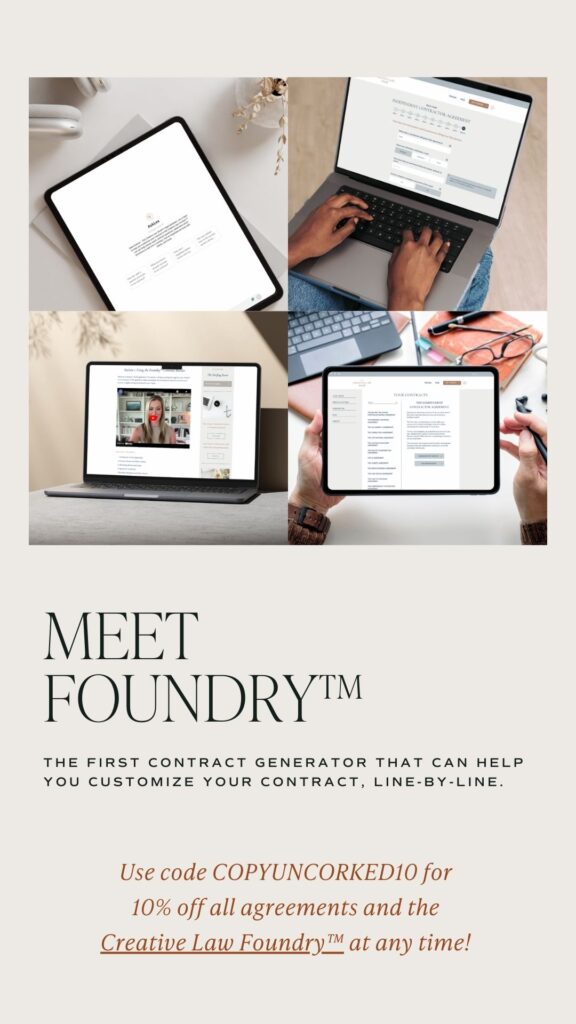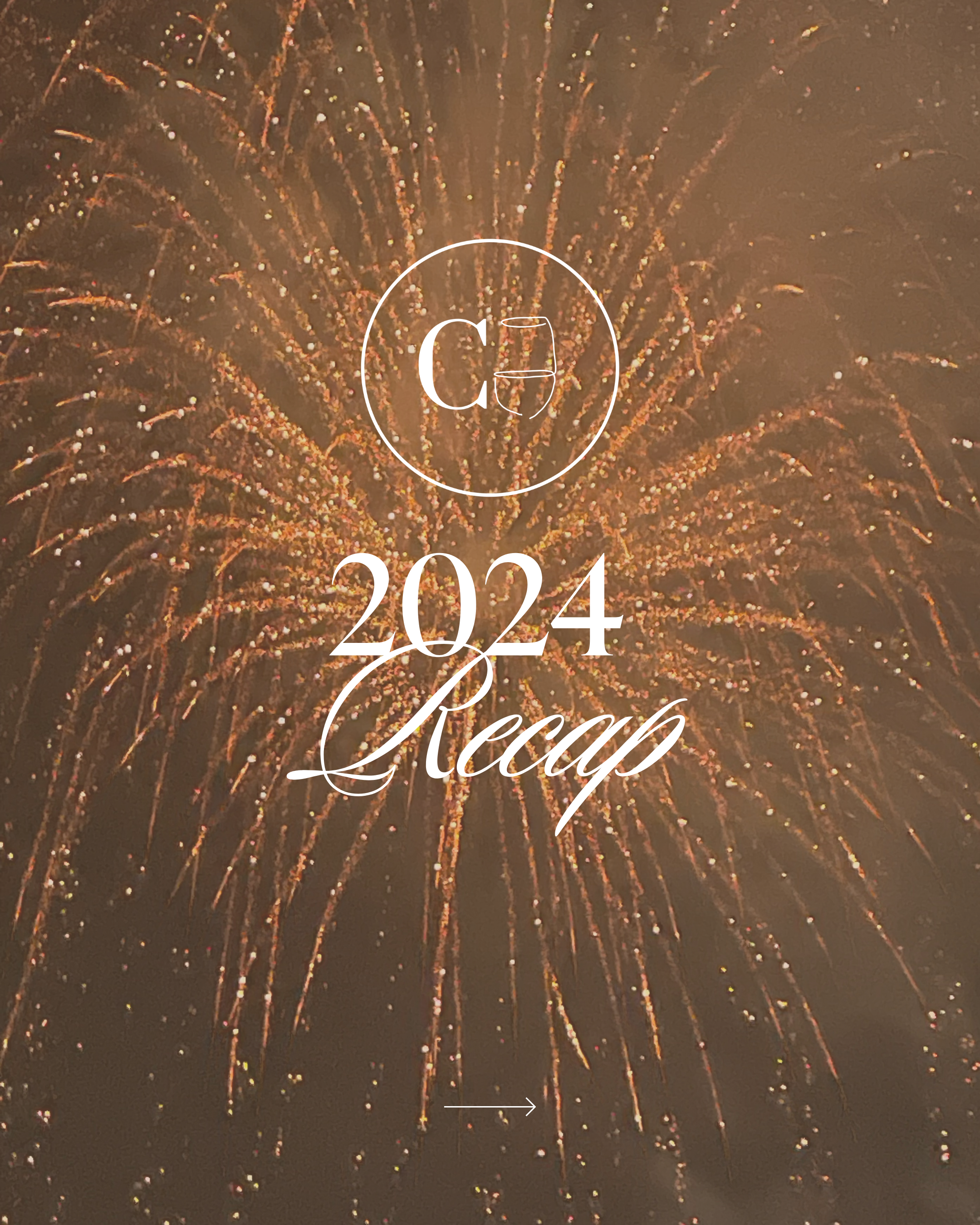The Three Provisions That Must Be Included In Your Copywriting Agreement
September 19, 2024
A Guest Blog Post from Paige Hulse – Founder/Owner of The Creative Law Shop®

I find copywriting to be a fascinating industry- the way in which a good copywriter becomes a wordsmith, who can enhance the words and message of each individual client is not an easy task. As a business owner who has had the incredible opportunity to work with copywriters such as the team at Copy Uncorked™, it is genuinely such an incredible experience to see a copywriter work their magic, and bring out the full potential of a project. That feeling of “those are the words I was looking for!” is like a sigh of relief when you’re launching a new product, a new website, a new company.
At the same time, for this exact same reason, the lawyer in me is aware that that is precisely why copywriters arguably have a slightly higher level of responsibility to manage the client’s expectations in order to fulfill a project to its full potential. After all, in order to adopt and enhance the client’s tone, or interlace a message with elements of story, or receive enough data to truly be a conversion copywriter, the copywriter must set the stage for a friendly and clear client experience.
You can’t actually read our minds, after all-even if it feels like it at times!
With that, copywriters must operate with a certain level of professionalism- you are artisans in a sea of creatives. A true professional will set clear boundaries and expectations for the project, creating forward momentum and allaying concerns before they arise. This means viewing your copywriting agreement as a roadmap for the client, so that they know exactly what to expect- and what is expected of both parties. No one likes scope creep, after all.
The word “professional” comes from the Latin “professus” or “profiteri”; meaning to profess or confess; to “put it out into the world”. In the Middle Ages, as the English and French languages adopted the term, it became “profes”; which means to “profess one’s vows”. Tracing its history through the centuries, the word took on the meaning of a person who was publicly “professing” his or her skills to the community, with a vow to perform their trade or craft at the highest standard. Therefore, those who would make a “public profession” regarding their trade (using that as a noun), became known as a “professional” (it shifted into being used as an adjective). These were the people who were trusted, who worked in specific trades, and had reputations to uphold in the community.
This is precisely what you are doing when you send your client your copywriting agreement.
These are the three provisions you need to provide in your copywriting contact with utmost clarity:
1. The Pause Clause
The “Pause Clause” is uniquely relevant for copywriting projects, perhaps more so than the majority of the creative industry. When looking back through the hundreds of creatives we’ve worked with over the years, the #1 dispute that has arisen for our copywriting clients has to do with clients ghosting a project (or a “pause”).
It is the copywriter’s professional responsibility to set forth what interactive work (ie review/revisions of drafts) and/or deliverables will be expected of the client. Within the law firm, we have spoken to clients who are disgruntled with the copywriter’s lack of clarity in this regard. Particularly when you are charging a premium price, you should anticipate that your client will not have copious amounts of free time to provide requisite feedback, etc.
On the other hand, the copywriter, of course, cannot actually be expected to read the client’s mind. Furthermore, it would be wholly inequitable to expect a copywriter to provide the specified deliverables with no feedback or input from the client, and then the client to claim breach of contract.
Additionally, as copywriters, your creativity is your currency. That means, of course, you must protect your time. You cannot allow a client to delay a project, and cause a hold up that affects your other clients.
Your Pause Clause should define for the client:
- What constitutes a “Pause” (how many days after a missed deadline is a project “paused”?)
- When does a “pause” in a project result in a halt in the project?
- What deliverables is the client responsible for providing to the copywriting team? For example, filling out questionnaires, submitting feedback, etc
These elements must be spelled out clearly, so that if, in a worst case scenario, you do have to cancel or reschedule a project, you cannot be held in “breach” for doing so. Sometimes life does get in the way of business, after all, and if your client must pause the work, this provision allows for an amicable solution to move forward.
You’ll note that I do not list the “cancellation or termination” provision as one of our “three most important” provisions, but this is intentional. Think of the provisions of your agreement as the threads of a tapestry weaving together to help successfully navigate away from, or through, a termination scenario.
A Pause Clause.
SAMPLE PAUSE CLAUSE CONTRACT LANGUAGE
Pause Clause. During the course of the Services, the Parties understand that a request to “pause” (“Pause”) the Services may occur. If the [VENDOR] requests to Pause the Services for any reason, [HE/SHE] shall promptly notify the Client. If a Pause delays the Services for more than [# OF DAYS], the Parties agree to enter into a [RESCHEDULING AGREEMENT/AMENDMENT] of this Agreement and sign an updated project timeline.
- Client’s Delay. If the Client requests to Pause the Services for any reason, including but not limited to failing to deliver any Necessary Deliverables to the [VENDOR] more than [# OF DAYS] past the [DELIVERABLE DATE], that results in a delay to either the [VENDOR] or any subcontractor of [VENDOR], the Client understands that this may cause a delay in the [“ESTIMATED COMPLETION DATE”] pursuant to the [VENDOR’S] current calendar availability. [The Client understands he/she may be required to sign an updated project timeline.] The [VENDOR] will notify the Client that a Pause has occurred subject to the Notice provision herein.
- “Necessary Deliverables” shall include, but are not limited to: delivery of content, completing any necessary questionnaires/forms required by the [VENDOR], and proof revisions. (note: define this section according to your own business’ specifications).
- If the Pause occurs beyond [# OF DAYS], the Client will be required to sign a cancellation agreement with the [VENDOR] and enter into a new Agreement to secure the [VENDOR’S] Services. If the Parties enter into a new Agreement in such an event, it will be subject to the [VENDOR’S] current pricing schedule at the date of signing.
2. Creative License
Once again, copywriters play such a unique role in a client’s project. Defining and enhancing the client’s voice is an art, and a skill you spent years cultivating.
With that, your contract should state that while the client has had the opportunity to view your portfolio, etc, you cannot be required to replicate another client or business’ voice, business name, slogan, etc. This provision is incredibly important in terms of setting the boundaries of what the client can expect from your work together, and also clearly states that the client agrees and understands that the copywriter has a dynamic and ever-evolving creative portfolio.
However, there’s another wrinkle to the Copywriter’s professional “creative license” that I want each and every copywriting professional to be aware of: if you are assisting a client with the naming of their business, or the creation of the slogan, in the strongest terms possible I suggest you work with an intellectual property attorney to run a full, legal due diligence search on that name. Unfortunately, in my intellectual property practice, I have worked with several clients who are fending off cease and desists or other infringement claims because the copywriter helped them name a business, or create a slogan which unknowingly infringed upon another brand. A USPTO search provides a false sense of security, and is not a due diligence search.
Of course, your copywriting contract likely does (and should) contain language that would help protect you in the event your work lands the client in legal hot water (such as an indemnification clause, intellectual property, limitation of liability, etc). However, there’s only so far your contract language will go in such a situation, in terms of protecting the harm to your reputation. Nothing will make a client lose trust faster than thinking that a copywriter was so liberal in their use of their “Creative License” that they got lazy, and cut corners that harmed the client.
So, if you do have a professional relationship with an intellectual property attorney, a portion of your creative license provision should include terminology stating that you will exercise that creative license in conjunction with a legal due diligence search.
3. Artificial Intelligence Disclaimer
As we know, the rapid rise of AI has infiltrated business on nearly every level. Similarly, it has infiltrated the legalities of our business contracts in ways we have not seen before, and will require you to examine your contracts in a new way.
I would posit that AI poses a unique opportunity, rather than a threat to jobs for copywriters in particular. While more and more business owners use AI for their copywriting needs, ideal clients are going to be searching for the true professionals; the artisans in a sea of creatives to add that human element that simply cannot be replicated. This is why I personally continue to work with the CU team.
This also means that you need an AI provision within your contract that clearly defines how and when you will use AI, as well as your responsibility to inform the client.
Breaking this down: the first question to address is how we define “the use of AI”? This is where we must balance the law and reality: for example, I would argue that using a tool such as ChatGPT to actually create some of the client deliverables does, obviously, constitute the “use of AI”, and should be disclosed to the client. On the other hand, if you use ChatGPT and ask it to poke holes in a draft, or to cross-examine a statement of persuasion you’re drafting for the client, but then actually revise the draft itself, that does not constitute “the use of AI” in a way that must be disclosed to the client.
This will be a line of discernment you must draw within your own business. No law currently exists mandating that you disclose the use of AI. However, it’s important to think ahead and premeditate what your client may or may not be looking for (or, more accurately, what your client may or may not think they can leverage later)
SAMPLE A.I. DISCLAIMER LANGUAGE
- So, for example: [VENDOR] agrees not to use AI-generated copy, images, artwork, design, and other visual elements for the [TYPE OF WORK] without [Client’s] prior express approval.* For purposes of clarification, [VENDOR] may use artificial intelligence technologies as a tool to assist in the creation of the [TYPE OF WORK], provided that the [VENDOR] has control over the final [WORK] and the [WORK] substantially comprises human creation.
- The vast majority of business owners will delete the first line, and we encourage the use of the second
- Right now, the key is to know how you would explain “how much AI” you are using in the final work product (subject matter of the client agreement)
*You can flip flop this sentence, and state “The [CLIENT] agrees that [VENDOR] may use AI technology….and is not required to obtain the [CLIENT]’s approval or permission”.
It will also be up to you, as a business owner, to decide if you want to require that the Client expressly signs off of your ability to use AI, or not. Again, right now, there is no case law that mandates whether or not a service provider can be limited in their ability to use AI; this will have to be a business determination you make for yourself.
One of the most common questions I receive is “how much of the final deliverable can be comprised of AI”, which is an extremely complicated question in this climate of legal uncertainty. However, I recommend to you what I recommend to all of my own clients: keep an eye on the Author’s Guild. I would argue that they broke out as the leaders of protecting creative liberties in the age of AI, and they recommend to all members of the Author’s Guild that no more than 5-10% of the final product may be comprised of AI.
One final note: you should have one primary AI provision in your agreement, but remember: a contract is a tapestry, woven together by the threads of each line of each provision. With that, ensure that your indemnification provision, your representations and warranties provisions, and your intellectual property provision all reference your AI policy.
In conclusion,
If you audit these three provisions within your copywriting agreement, and ensure that they fully reflect your company’s policies and procedures, operate in confidence, knowing that you have a contract that will facilitate a productive client relationship. If you aren’t sure about any of the provisions mentioned above, or if you are not sure how to amend or negotiate a provision that a client may ask to revise, or push back on, the Creative Law Foundry™ is the first of its kind, AI-powered contract generator. The Creative Law Foundry™ will allow you to build a copywriting contract based upon the agreement I wrote for my own copywriting clients, and customize it to fit your business’ needs, client by client.

Cheers,
Paige
Founder/Owner of The Creative Law Shop®






Read the Comments +